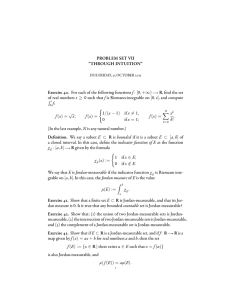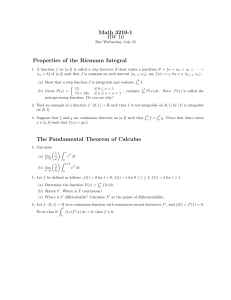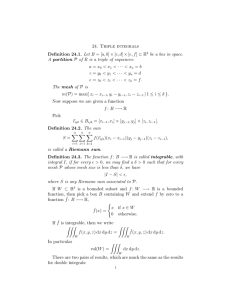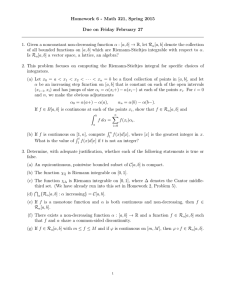22. Double integrals
advertisement
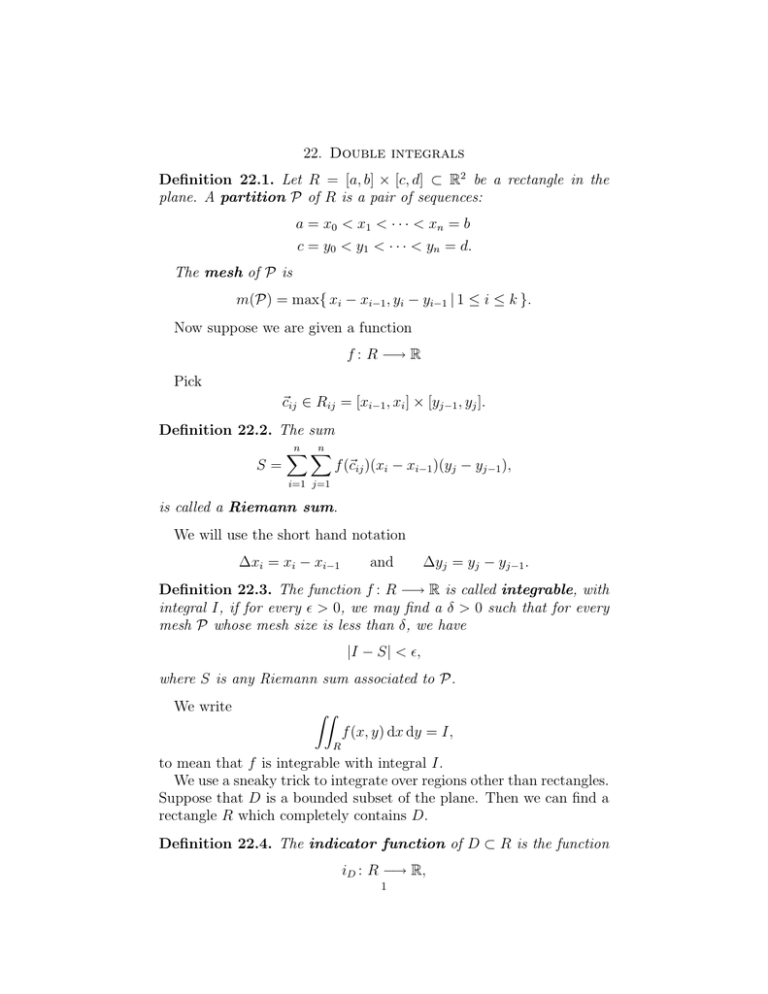
22. Double integrals
Definition 22.1. Let R = [a, b] × [c, d] ⊂ R2 be a rectangle in the
plane. A partition P of R is a pair of sequences:
a = x0 < x1 < · · · < xn = b
c = y0 < y1 < · · ·
< yn = d.
The mesh of P is
m(P) = max{ xi − xi−1 , yi − yi−1 | 1 ≤ i ≤ k }.
Now suppose we are given a function
f : R −→ R
Pick
�cij ∈ Rij = [xi−1 , xi ] × [yj−1 , yj ].
Definition 22.2. The sum
n �
n
�
S=
f (�cij )(xi − xi−1 )(yj − yj−1 ),
i=1 j=1
is called a Riemann sum.
We will use the short hand notation
Δxi = xi − xi−1
and
Δyj = yj − yj−1 .
Definition 22.3. The function f : R −→ R is called integrable, with
integral I, if for every � > 0, we may find a δ > 0 such that for every
mesh P whose mesh size is less than δ, we have
|I − S| < �,
where S is any Riemann sum associated to P.
We write
� �
f (x, y) dx dy = I,
R
to mean that f is integrable with integral I.
We use a sneaky trick to integrate over regions other than rectangles.
Suppose that D is a bounded subset of the plane. Then we can find a
rectangle R which completely contains D.
Definition 22.4. The indicator function of D ⊂ R is the function
iD : R −→ R,
1
given by
�
1
iD (x) =
0
if x ∈ D
if x ∈
/ D.
If iD is integrable, then we say that the area of D is the integral
��
iD dx dy.
R
If iD is not integrable, then D does not have an area.
Example 22.5. Let
D = { (x, y) ∈ [0, 1] × [0, 1] | x, y ∈ Q }.
Then D does not have an area.
Definition 22.6. If f : D −→ R is a function and D is bounded, then
pick D ⊂ R ⊂ R2 a rectangle. Define
f˜: R −→ R,
by the rule
�
f (x)
f˜(x) =
0
if x ∈ D
otherwise.
We say that f is integrable over D if f˜ is integrable over R. In this
case
��
��
f (x, y) dx dy =
f˜(x, y) dx dy.
D
R
2
Proposition 22.7. Let D ⊂ R be a bounded subset and let f : D −→
R and g : D −→ R be two integrable functions. Let λ be a scalar.
Then
(1) f + g is integrable over D and
� �
��
��
f (x, y) + g(x, y) dx dy =
f (x, y) dx dy +
g(x, y) dx dy.
D
D
D
(2) λf is integrable over D and
� �
��
λf (x, y) dx dy = λ
f (x, y) dx dy.
D
D
(3) If f (x, y) ≤ g(x, y) for any (x, y) ∈ D, then
� �
��
f (x, y) dx dy ≤
g(x, y) dx dy.
D
D
2
(4) |f | is integrable over D and
��
|
��
f (x, y) dx dy| ≤
|f (x, y)| dx dy.
D
D
It is straightforward to integrate continuous functions over regions
of three special types:
Definition 22.8. A bounded subset D ⊂ R2 is an elementary region
if it is one of three types:
Type 1:
D = { (x, y) ∈ R2 | a ≤ x ≤ b, γ(x) ≤ y ≤ δ(x) },
where γ : [a, b] −→ R and δ : [a, b] −→ R are continuous functions.
Type 2:
D = { (x, y) ∈ R2 | c ≤ y ≤ d, α(y) ≤ x ≤ β(y) },
where α : [c, d] −→ R and β : [c, d] −→ R are continuous functions.
Type 3: D is both type 1 and 2.
Theorem 22.9. Let D ⊂ R2 be an elementary region and let f : D −→
R be a continuous function.
Then
(1) If D is of type 1, then
� b ��
��
�
δ(x)
f (x, y) dx dy =
f (x, y) dy
D
a
dx.
γ(x)
(2) If D if of type 2, then
��
�
d
��
f (x, y) dx dy =
D
�
β(y)
f (x, y) dx
c
dy.
α(y)
Example 22.10. Let D be the region bounded by the lines x = 0,
y = 4 and the parabola y = x2 . Let f : D −→ R be the function given
by f (x, y) = x2 + y 2 .
3
If we view D as a region of type 1, then we get
�
��
� 2 �� 4
2
2
f (x, y) dx dy =
x + y dy dx
D
x2
0
� 2�
=
0
y3
x y+
3
2
�4
dx
x2
2
26
x6
− x4 −
dx
3
3
0
� 3
�2
4x
26 x x5
x7
−
−
=
+
3
3
5
3·7 0
5
7
5
7
2
2
2
2
=
+
−
−
3
3
5
3·7
6
8
2
2
=
+
3 ·�5
7
�
1
22
6
=2
+
.
3·5
7
On the other hand, if we view D as a region of type 2, then we get
�
��
� 4 �� √y
2
2
f (x, y) dx dy =
x + y dx dy
�
4x2 +
=
D
0
0
� 4�
=
0
�
3
x
+ xy 2
3
�√ y
dy
0
4 3/2
y
=
3
0
+ y 5/2 dy
�4
2y 5/2 2y 7/2
=
+
3·5
7 0
26
28
=
+
3 ·�5
7
�
1
22
6
=2
+
.
3·5
7
�
4
MIT OpenCourseWare
http://ocw.mit.edu
18.022 Calculus of Several Variables
Fall 2010
For information about citing these materials or our Terms of Use, visit: http://ocw.mit.edu/terms.

